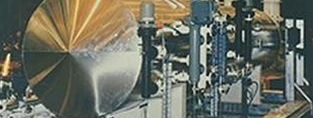
- (03) 5909 8218
- enquiry@fusionweld.com.au
Primary Functions of Oil and Gas Separators
March 8, 2017

Oil well streams require separation. Granted, the crude black stuff is a prized commodity, but it has to be split into two fundamental states before it can be properly processed. Oil and gas separators are required to carry out this processing magic. It's not some kind of mysterious sorcery. Quite the opposite, in fact, this is a chemically-based procedure, one that's used on oil rigs and onshore facilities.
Primary Functions
Oil and gas separators are vital members of the pressure vessel family. They basically cleave the crude discharge in two. This remarkable action is made possible by phase separation mechanisms installed within pressure vessels. This isn't a true fractionization process, of course. That chemically active work is reserved for a fractional distillation tower. Instead, this is the front-end of the processing chain, a stage that divides the crude commodity into liquids, gases, and water.
Stage Separation
On a fundamental level, oil and gas separators operate a little like a filtration system. These aren't filters, of course, but the characteristics of the design do share some common features with an intricate sieving assembly. Primarily, the pressure vessels are located close to the wellhead. They conduct an immediate separation cycle so that oil, gas, water, and stream contaminants are divorced from one another. A second stage, perhaps even a third stage, adds processing power to the state segregating procedure, thus removing liquid particles from a gas, gas vapours from a gas-saturated liquid, and water droplets from both of these critically important hydrocarbon resources.
Internal Processing Components
Every sub-system inside the separator pressure vessel is state isolation-dedicated. That means that gravity separators are in place, as are mist extractors, cyclones, heated water baths, and much more. These are the fluid agitation solutions that actively look for the oil and gas mediums so that precious resources can be stored or relayed to the next processing sub-system. Handily, these processing methods are also separable, with centrifugal force, agitation, and heat topping the processing bill on this occasion.
Crude oil is a murky, contaminated stuff. Although trapped in shale deposits for millennia, its fluid base has become saturated with water and sedimentary particles. Oil and gas separators are the upstream solutions for this mucky, murky mess. They split the two valuable states, oil and gas, so that they're prepped for any and all secondary or tertiary refinement stations. In the meantime, those same pressure vessels are divorcing the streams from sediments, water, and all waste.
Contact Details
Fusion - Weld Engineering Pty Ltd
ABN 98 068 987619
1865 Frankston Flinders Road,
Hastings, VIC 3915
Ph: (03) 5909 8218
Optimized by NetwizardSEO.com.au
Recent Posts
- Heat Exchanger Maintenance in Melbourne: Minimising Risk in Power Generation Facilities
- Compressed Hydrogen Storage Vessels: Material Selection, Design & Australian Standards
- Welding QA/QC in Oil & Gas Pressure Vessel Fabrication – Ensuring Code Compliance
- AS1210 vs ASME VIII Pressure Vessel Code: Key Differences for Australian Projects
- Mitigating Hydrogen-Induced Cracking in Pressure Vessels: Engineering and Material Strategies
- Storage Tank Solutions Australia: Field-Erected, Prefabricated & Self-Bunded Explained
- Reducing Environmental Risks: Self-Bunded Tanks in Australian Oil & Gas Operations
- Precision in Production: How Pressure Vessels Are Manufactured for Industrial Safety
- Shell & Tube Heat Exchangers: Improve Thermal Control & Energy Recovery in Petrochemical & Pharmaceutical Plants
- In-Service Inspection for Compressed Air Receivers for Power Plant Shutdown Prevention
- Power Plant Pipe Spooling Fabrication – Get Rapid, Code-Compliant Spools Ready for Installation
- Field Erected Tanks: Safe, Reliable On-Site Fuel Storage Solutions in Australia
Posts 2026
- Heat Exchanger Maintenance in Melbourne: Minimising Risk in Power Generation Facilities
- View all articles…
Posts 2025
- Compressed Hydrogen Storage Vessels: Material Selection, Design & Australian Standards
- Welding QA/QC in Oil & Gas Pressure Vessel Fabrication – Ensuring Code Compliance
- View all articles…
Posts 2024
- Large Process Vessels: Optimising the Design for Maximum Efficiency [2025]
- Pressure Equipment Management System Installation: Detect Equipment Faults Early
- View all articles…
Posts 2023
- Pressure Piping System Inspection: A Gift of Safety for the Holidays
- Deaerator Inspections by Fusion-Weld Engineering and How They Reduce System Downtime
- View all articles…
Posts 2022
- How Fusion Weld Keeps Up With AS-NZS ISO 9001:2008 Standard
- Boiler Equipment Safety Inspection During the Summer Season
- View all articles…
Posts 2021
- Avoid These Factors and Practices that Contribute to Sealing Damage in Pressure Vessels
- Do's And Don'ts Of Industrial Boiler Inspection And Maintenance From Fusion-Weld
- View all articles…
Posts 2020
- What are the Risks and Hazards Involved in Pressure Vessel Equipment?
- How to Know if Your Pressure Equipment Needs Repair or Replacement?
- View all articles…
Posts 2019
- Factors that Contribute to Pressure Vessel Failure
- Pressure Vessel Regulations in Australia: What are the Mandatory Requirements?
- View all articles…
Posts 2018
- Pros and Cons of Spherical vs. Cylindrical Pressure Vessels
- What are the Different Hazard Levels in Pressure Vessels?
- View all articles…
Posts 2017
- Transportable Pressure Vessels: The Importance of Inspection and Safety Checks
- Fracture Mechanics and Stress Analysis of Cracks in Pressure Vessels
- View all articles…
Posts 2016
Posts 2015
- What Are Deaerators & Feedwater Vessels?
- Precautions and Safety for Compressed Air Receiver Vessels
- View all articles…
Posts 2014
- Demonstrating In-process Inspection Procedures
- Static Grounding Practices and Standards
- View all articles…